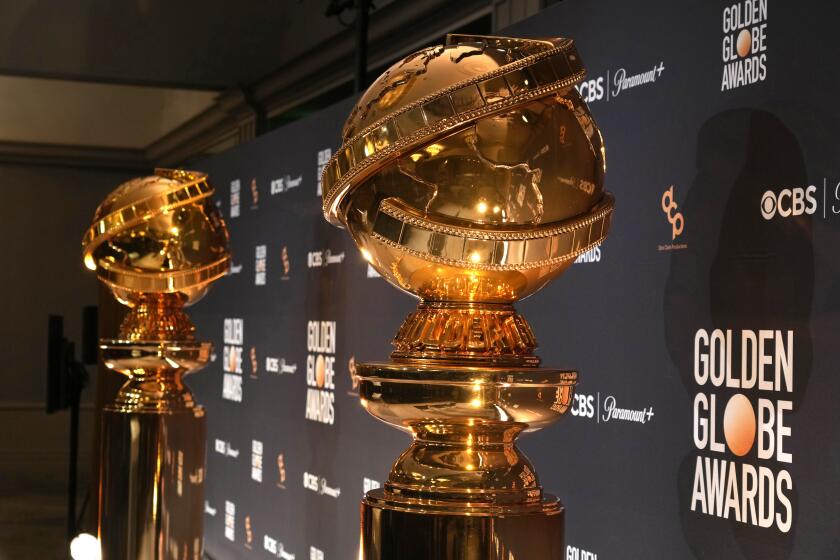‘Miniature Colossus’ on Display : Hollywood of the 1940s Lives On in Small Way
- Share via
While Hollywood in the 1940s shimmered with glamour, cranking out such classics as “Casablanca” and “Citizen Kane” to build its larger-than-life image, cabinetmaker Joe Pellkofer worked on a smaller scale.
Humphrey Bogart, Bing Crosby, and Cary Grant were the screen heartthrobs, Oscars were made of plaster, World War II brought rationing and “The Bugle Call Rag,” and movie work paid $11.08 a day.
Pellkofer, 80, froze in time that era of Hollywood by duplicating the city in miniature with a team of 25 craftsmen at a cost of $250,000 over four years during the ‘40s.
“We were after the perfect miniatures. . . . We even chipped some of the original paint off the Chinese Theater so we could match it to its original color,” Pellkofer said.
Photographed Locations
They photographed all locations and even timed the surf at Malibu to get it all just right.
Six models were built in Pasadena next to Pellkofer’s cabinetmaking shop. They depicted Hollywood, the Malibu film colony with its seaside celebrity homes, a composite of that era’s film studios, Grauman’s Chinese Theater (now Mann’s Chinese) with its celebrity footprints cast in concrete, the Hollywood Bowl and the now-extinct Brown Derby on Wilshire Boulevard.
The Hollywood portion is 11 by 12 feet with 45 main blocks and 450 buildings all built to scale. A clock controls the lights inside the structures and the street lamps that cast shadows on cars of the era parked below.
In January, 1946, the exhibit opened in Hollywood, then toured the nation for two years to rave reviews. Columnist Hedda Hopper called the miniatures breathtaking, and the New York Daily News said: “What a whale of a job. . . . It’s a miniature colossus.”
At one point, the entire exhibit was stolen while on display for a police department in Oregon. It was later found intact in the custody of a South Carolina sheriff’s department.
In 1948, after making the rounds of department stores and fairs and raising money for charities, Pellkofer brought his creation home and stored it in his barn.
38 Years in Barn
It stayed there 38 years, never to be seen publicly again until last February.
Pellkofer’s grandson, John Accornero, wrote Hollywood Heritage, a preservationist group, and told them about the forgotten, dust-covered city. Heritage founder Marian Gibbons said she was instantly enthralled and quickly found four partners to help restore them.
“They were just so spectacular, I was determined to save them,” she said.
Today the exhibit is called “On Location” and is back in Hollywood, on the ground floor of the El Capitan building on Hollywood Boulevard next to the Paramount Theater.
A 12-minute walk-through costs adults $2.50, but children under 12 go free.
Paramount manages the retail part of “On Location” and predicts $5 million in first-year gross sales.
Gibbons and her partners paid $250,000, just what it cost Pellkofer to build it. They created a set for it and added a 1940s-style lunch counter, soda fountain, lots of neon, a retail store and piped-in recordings of the Andrews Sisters. Total investment: about $750,000.
Gibbons enlisted Landmark Entertainment Group to construct a replica of the Paramount Studio lot and supply fiber-optics effects to light up the skyline.
Four Miniatures Displayed
Only four of the miniatures are on display: Hollywood, Malibu, the Chinese Theater with its ivory and copper facade and tiny sidewalk with tiny hand and footprints, and the new Paramount replica. There was not room for the miniatures of the Hollywood Bowl or the historic studio composite. The Brown Derby miniature was destroyed during the tours in the ‘40s.
“I didn’t build the damned thing to see a movie star,” Pellkofer said, but the cabinetmaker who lives with his wife, Josie, in La Habra Heights said he hopes “some of the old-time stars will come to see it. They lived here.”
More to Read
The biggest entertainment stories
Get our big stories about Hollywood, film, television, music, arts, culture and more right in your inbox as soon as they publish.
You may occasionally receive promotional content from the Los Angeles Times.










